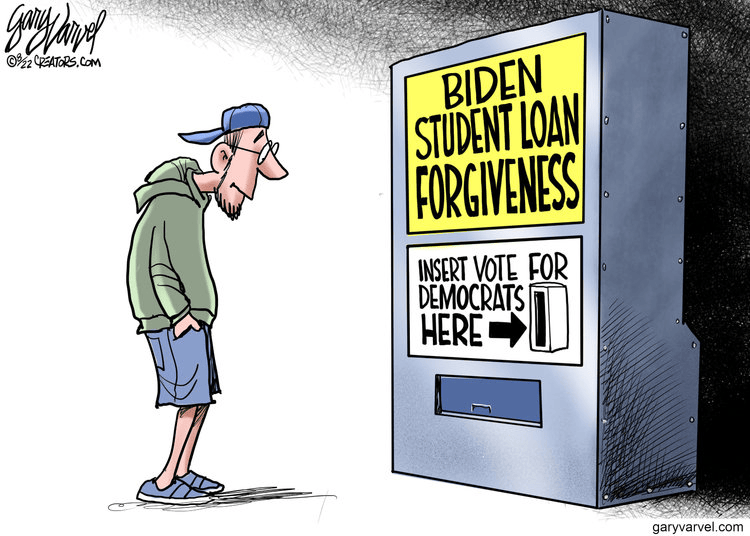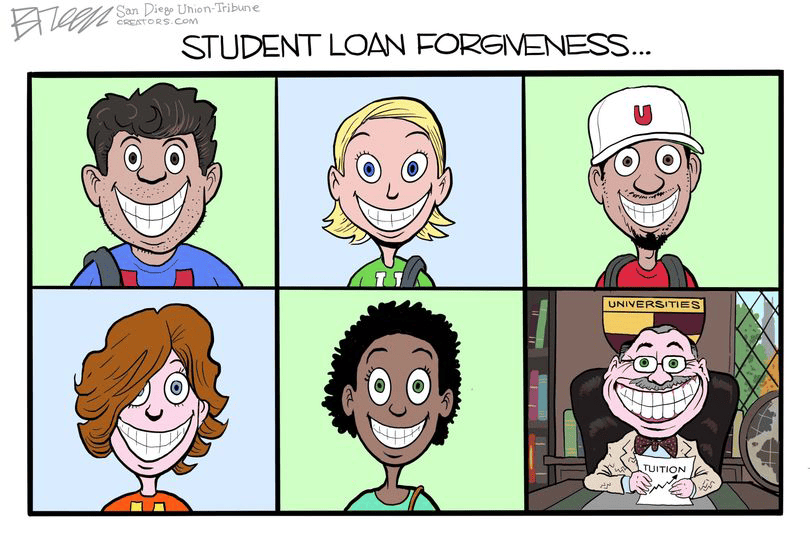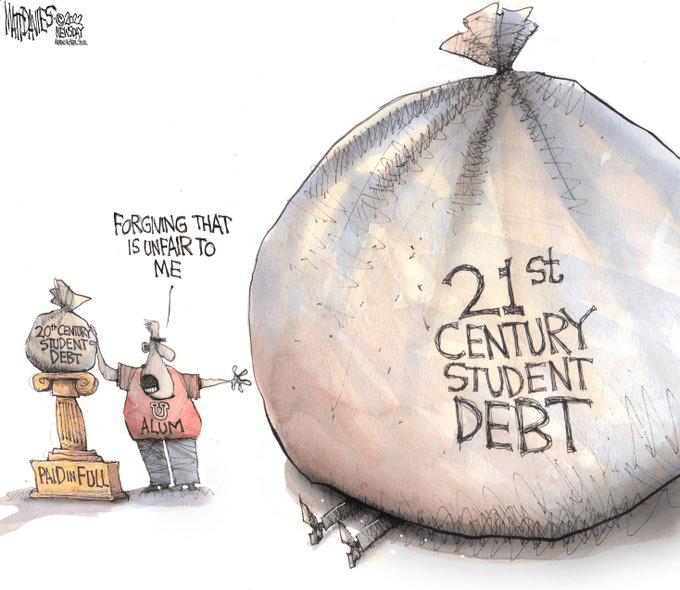
Biden’s decision to cancel a portion of student loan debt is top of the news, and Kevin Siers makes the point that, while it’s not a cure-all, lot of people wanted it to happen.
It’s a sign of the times that doing something a lot of people wanted you to do carries a tinge of partisan self-interest, but here we are. It’s a reverse-twist on the old joke that, if Obama or Biden recommended that people breathe, a lot of Republicans would suffocate, and that’s a large part of the negative response from their side of the aisle.
Juxtaposition of the Day


There are several variations on the Class Warfare take, but these two span the width: Varvel agrees with Siers that it will make Democrats more attractive to college-educated voters, but insists that people who go to college are elitist goofballs.
Gorrell depicts people who didn’t go to college as stupid-looking, which seems like an insult to his own demographic, but victimhood is key to conservative politics, so the message is that the elites are exploiting us again, and that only a stupid sucker would stand for such a thing.

Class issues around college are nothing new, and here’s something I wrote on the topic five years ago:
College was once the province of the elite, and collegiate novels — starting in 1861 with “Tom Brown at Oxford,” which was copied a half century later in “Stover at Yale” — focused on rich, spoiled spendthrifts who contrasted with a small group of serious students who had genuinely shown up to learn.
One of the things I noted, in going from being a student at a private college to living among students at the University of Colorado, was that there were far more students at CU who were blue collar, minorities and Vietnam vets, which I ascribe to a practical need to get the sheepskin and get to work.
Juxtaposition of the Day #2



Anderson points out, before we all get too carried away, that the forgiveness being offered is far from complete, and the person who piled up $50,000 in debt to pursue a degree in art history is still going to have to deal with most of it, albeit with some grace in that payments will be tempered by the art historian’s pay at Wendy’s.
That benefit aside, there are a lot of limitations and restrictions. Here’s a guide to the Good News/Bad News involved.
Bok is somewhat off the mark, because students aren’t richer, exactly, and would be foolish indeed to think they now have “free money” to throw around.
On the other hand, there is an element of foolishness involved in the ways schools have added fripperies like climbing walls to attract students, and both Bok and Breen have a valid point that this move doesn’t address the rising cost of college.

We used to say “War is good business; Invest your son,” but college has since then become good business. The interactive form of this graph will let you pin it down more precisely, but the basic fact is that, while the draft made going to college attractive for guys during Vietnam (half our specific demographic served anyway), the growth in enrollment since then has been mirrored by a growing refusal by employers to interview those without diplomas for professional positions.

Matt Davies rightly notes the contrast between those who went to college a generation or two ago and those paying for those rock-climbing walls and exotic food courts today.
This Grumpy Old Man will note that my freshman year dorm not only had no cooking or laundry facilities, but also no carpets or drapes.
More to the point, as I wrote nearly 30 years ago

Today, the median per-capita income is $35,384, but median total cost per year at a private university is $54,501, while public college will still set you back about $25,707. (And, BTW, that house now has a Zillow estimated value of $500,600.)
Point being that, first, if a full third of young people are graduating from college, it’s no longer an “elitist” matter, and, second, chipping 10 or 20 grand off the bill is a good gesture, but it’s hardly a cure for what ails us.
What ails us is that we’re grudgingly willing to pay for K-12 education, but not nearly as committed to workforce development in the final four years.

Matt Wuerker (Politico) is hardly the only person to note that relieving the pressure on indebted students is being criticized by people who have had no problem with legislation relieving the pressure on themselves, and who, by the way, still believe — against all historical evidence — in the theory of trickle-down economics, otherwise known as “A rising tide lifts all yachts.”
In order to understand the economic impact of Biden’s loan forgiveness, you need to realize that those who benefit will do so not by a huge cash infusion but by having less of their paychecks go to debt repayment, which will free that money to go into the economy in another form of trickle.
Will it cost the government? Like a lot of those questions, it depends on who does the math and what answer they’re being urged to find.
And it has been noted by others that “How are you going to pay for that?” is rarely asked about the Defense budget or tax cuts for plutocrats who don’t pay their fair share to begin with.

Ted Rall (AMS) summarized the real objection in this April cartoon: I went barefoot, so why should my neighbor’s child have shoes?
And, while opponents have found people to complain that they paid off college and so nobody else should get help, social media has been flooded with people saying they paid off their loans and are happy to see others get the breaks they never had.
As well as things like this Twitter thread noting the number of complainants who, having taken advantage of the system to score dubious PPP loans in the first place, then ducked out on them at government expense. (The White House also noticed.)
Meanwhile, this PSA is part of the mix, given that some state legislators seem to also question whether children should be fed.
I accrued about $5k of college debt in the late 1970s. Interest on the loan was 3% and my state paid the interest while I was in school. $5k is about $20k in today’s dollars and was about 30% of my annual starting salary after graduation.
The terms of the loan were that once I graduated and began working, I was to call the bank and set up a payment schedule. Which I did — but the officer at the bank was shocked when I did so. Apparently many of my cohort just defaulted on the loans instead.
I don’t strong feelings about student loan forgiveness. My perspective is: I got a pretty good deal, the loan really helped me, I wish others the best, but I doubt the deal I got exists any more.
Regarding Chip Bok’s cartoon, I did witness something similar in the 1990s when the state of Georgia instituted HOPE scholarships. While the state had made tuition affordable for a larger number of students, many of the universities raised other attendance fees since students could now afford more.
Lonny, your experience with loans was almost exactly like mine, except that my college handled the payments and really did expect me to pay the money back. They gave me several hardship deferments until I got a (low-paying) job, then a second (lower-paying) job. It took me a few years to pay it off. You’re right, those deals with 3% and 5% interest are long gone. I’m glad today’s students are getting a break.
Another one of the lucky boomers here: Mom and dad paid for my Bachelor’s (and my sister’s entire medical degree, OK our family was well-off middle class), and I paid for my Master’s by working in at Erie Malleable Iron as a dues paying member until the Steelworker’s Union. Making the princely sum of $11,000/year in 1974.
Having said that, mark me as another who’s happy as hell for the loan bailout. Modern reality was thrust on me marrying my third wife seven years ago, realizing that she came complete with $25,000 in student debt which went to a rip-off, for-profit institution that promptly went belly up leaving her with no degree and no transferrable credits. Yeah, her mistake. Just the same, if there’s any group that deserves complete wiping away of the debt . . . .
Unless it was part of the legislation to avoid this, those receiving this benefit may be surprised to find a tax bill in the mail next April at income tax time. I don’t know if it is still on the books at the federal and state levels, but at least at some time in the past, debt forgiveness was considered as income and subject to income tax. While still paying their student loans monthly, folks may be surprised to find an added tax surcharge instead of a tax refund come next April. Maybe someone out there has more knowledge about this.
AIUI existing policy (legislation?) exempts student loan forgiveness from federal income tax; thirteen states (or thereabouts) currently treat it as taxable income, but at least some can be expected to pass legislation quickly to provide exemptions.
That twitter thread “noting the number of complainants” is worth taking a look at. Once you figure out what’s going on it’s hilarious. “This you?” And it just goes on and on.